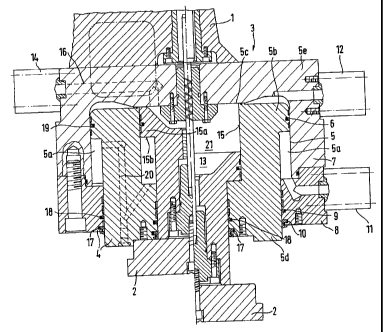Some of the information on this Web page has been provided by external sources. The Government of Canada is not responsible for the accuracy, reliability or currency of the information supplied by external sources. Users wishing to rely upon this information should consult directly with the source of the information. Content provided by external sources is not subject to official languages, privacy and accessibility requirements.
Any discrepancies in the text and image of the Claims and Abstract are due to differing posting times. Text of the Claims and Abstract are posted:
| (12) Patent: | (11) CA 2457177 |
|---|---|
| (54) English Title: | ROLLING MILL STAND FOR THE ROLLING OF DIFFERENT ROLLED STOCK WHICH REQUIRE DIFFERENT ROLLING FORCES |
| (54) French Title: | CAGE DE LAMINOIR DESTINEE AU LAMINAGE DE DIFFERENTS LAMINES NECESSITANT DIFFERENTES FORCES DE LAMINAGE |
| Status: | Deemed expired |
| (51) International Patent Classification (IPC): |
|
|---|---|
| (72) Inventors : |
|
| (73) Owners : |
|
| (71) Applicants : |
|
| (74) Agent: | FETHERSTONHAUGH & CO. |
| (74) Associate agent: | |
| (45) Issued: | 2010-09-07 |
| (86) PCT Filing Date: | 2002-08-16 |
| (87) Open to Public Inspection: | 2003-03-13 |
| Examination requested: | 2007-05-14 |
| Availability of licence: | N/A |
| (25) Language of filing: | English |
| Patent Cooperation Treaty (PCT): | Yes |
|---|---|
| (86) PCT Filing Number: | PCT/EP2002/009195 |
| (87) International Publication Number: | WO2003/020452 |
| (85) National Entry: | 2004-02-12 |
| (30) Application Priority Data: | ||||||
|---|---|---|---|---|---|---|
|
The invention relates to a roll stand for rolling different rolling stock that
requires different roll separating forces. The inventive roll stand comprises
working rolls, back-up rolls, optionally a roll bending device for the working
rolls and optionally a device for adjusting and balancing the back-up rolls,
and pairs of adjustment cylinders (3) between the roll stands (1) and the
chocks (2). According to the invention, the adjustment cylinders (3) consist
of respective telescope cylinders (4), in which a first, concentric cylinder
(5) having a large diameter is provided for high roll separating forces and a
second, concentric cylinder (15) having a smaller diameter is provided for
lower roll separating forces, thereby avoiding high friction losses.
L'invention concerne une cage de laminoir destinée au laminage de différents laminés nécessitant différentes forces de laminage. Cette cage comprend des cylindres de travail, des cylindres d'appui, éventuellement un dispositif de pliage destiné aux cylindres de travail et éventuellement un équipement destiné au réglage et à l'équilibrage de cylindres d'appui et des paires de cylindres de réglage (3) placés entre les montants de laminoir (1) et les empoises (2) permettent d'éviter les grandes pertes par frottement, de telle façon que les cylindres de réglage (3) soient respectivement composés d'un cylindre télescopique (4) qui renferme un premier cylindre concentrique (5) de grand diamètre pour des forces laminage élevées et un deuxième cylindre concentrique (15) de petit diamètre pour de petites forces de laminage.
Note: Claims are shown in the official language in which they were submitted.
Note: Descriptions are shown in the official language in which they were submitted.

For a clearer understanding of the status of the application/patent presented on this page, the site Disclaimer , as well as the definitions for Patent , Administrative Status , Maintenance Fee and Payment History should be consulted.
| Title | Date |
|---|---|
| Forecasted Issue Date | 2010-09-07 |
| (86) PCT Filing Date | 2002-08-16 |
| (87) PCT Publication Date | 2003-03-13 |
| (85) National Entry | 2004-02-12 |
| Examination Requested | 2007-05-14 |
| (45) Issued | 2010-09-07 |
| Deemed Expired | 2013-08-16 |
There is no abandonment history.
| Fee Type | Anniversary Year | Due Date | Amount Paid | Paid Date |
|---|---|---|---|---|
| Application Fee | $400.00 | 2004-02-12 | ||
| Registration of a document - section 124 | $100.00 | 2004-05-13 | ||
| Maintenance Fee - Application - New Act | 2 | 2004-08-16 | $100.00 | 2004-07-20 |
| Maintenance Fee - Application - New Act | 3 | 2005-08-16 | $100.00 | 2005-07-22 |
| Maintenance Fee - Application - New Act | 4 | 2006-08-16 | $100.00 | 2006-07-20 |
| Request for Examination | $800.00 | 2007-05-14 | ||
| Maintenance Fee - Application - New Act | 5 | 2007-08-16 | $200.00 | 2007-08-10 |
| Maintenance Fee - Application - New Act | 6 | 2008-08-18 | $200.00 | 2008-08-06 |
| Maintenance Fee - Application - New Act | 7 | 2009-08-17 | $200.00 | 2009-07-23 |
| Registration of a document - section 124 | $100.00 | 2009-08-11 | ||
| Final Fee | $300.00 | 2010-06-10 | ||
| Maintenance Fee - Application - New Act | 8 | 2010-08-16 | $200.00 | 2010-06-10 |
| Maintenance Fee - Patent - New Act | 9 | 2011-08-16 | $200.00 | 2011-08-04 |
Note: Records showing the ownership history in alphabetical order.
| Current Owners on Record |
|---|
| SMS SIEMAG AKTIENGESELLSCHAFT |
| Past Owners on Record |
|---|
| DENKER, WOLFGANG |
| SMS DEMAG AKTIENGESELLSCHAFT |